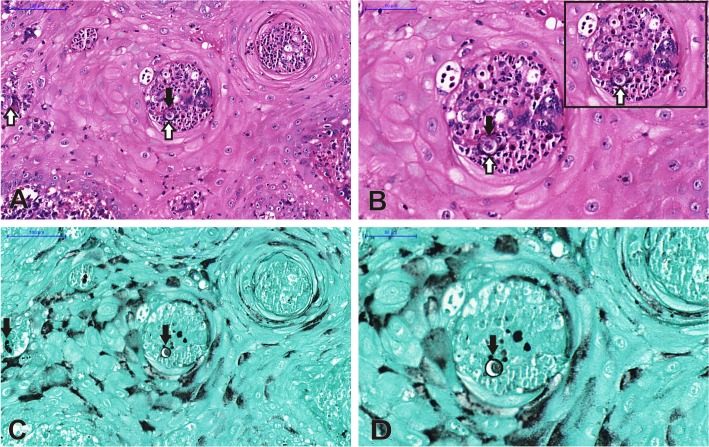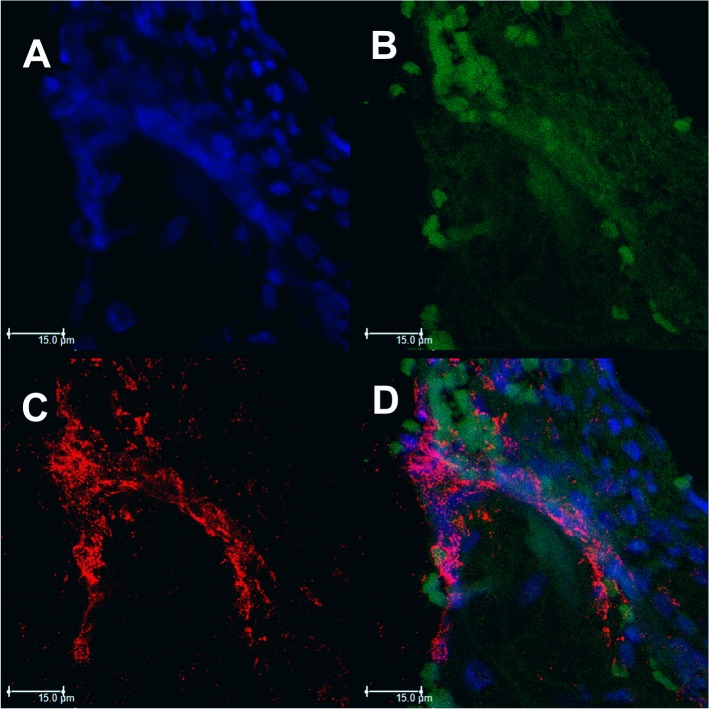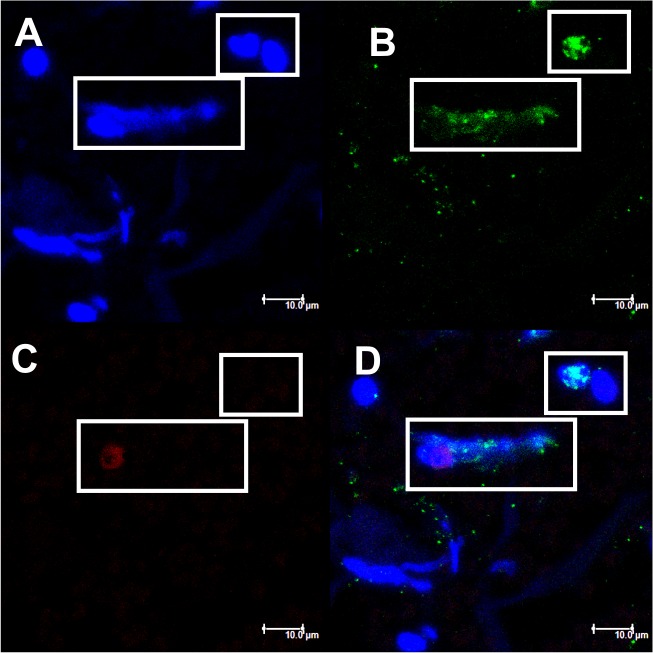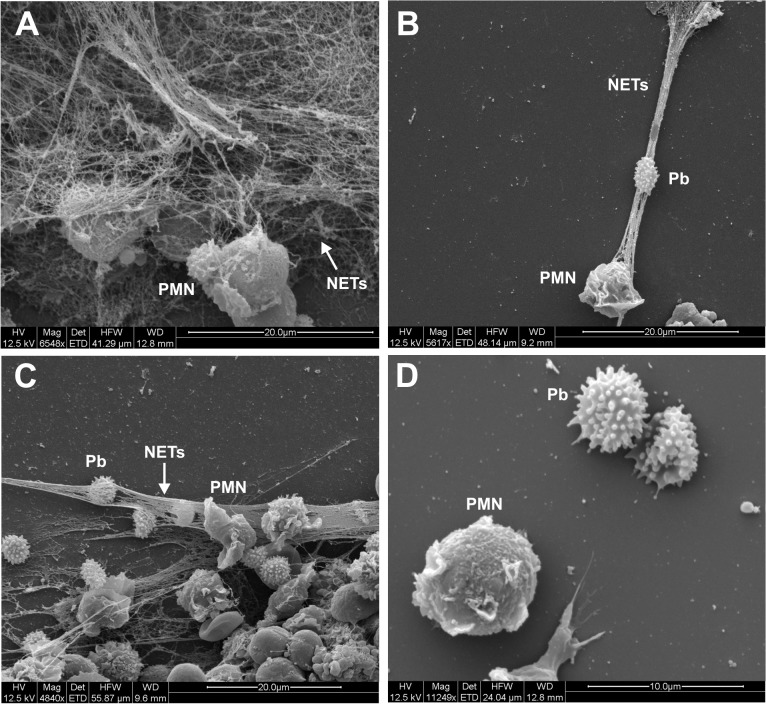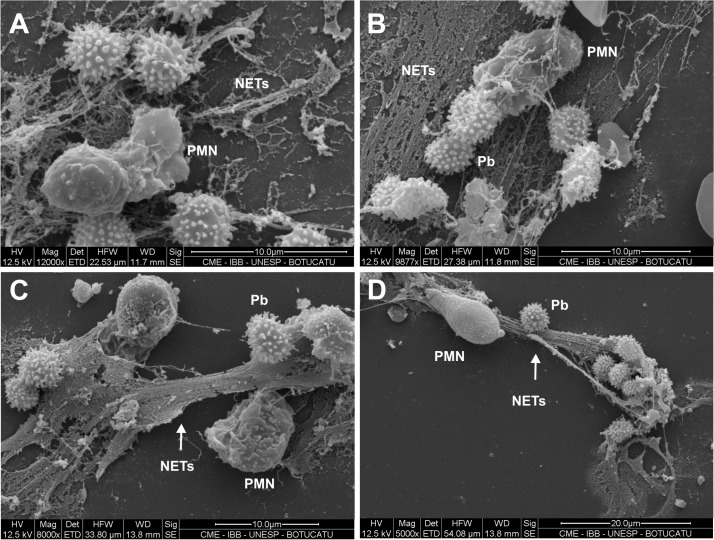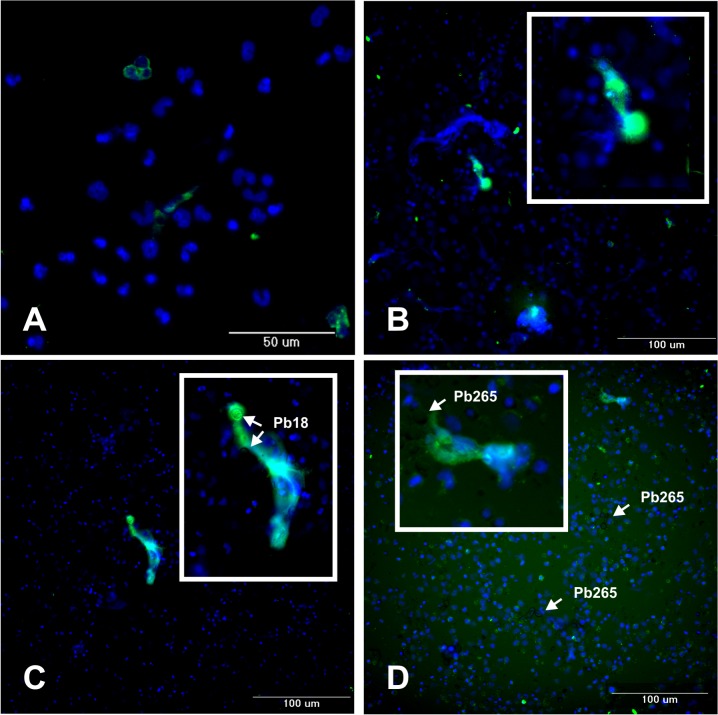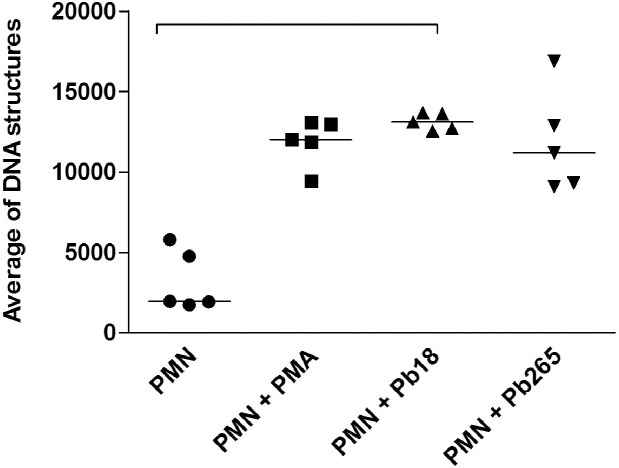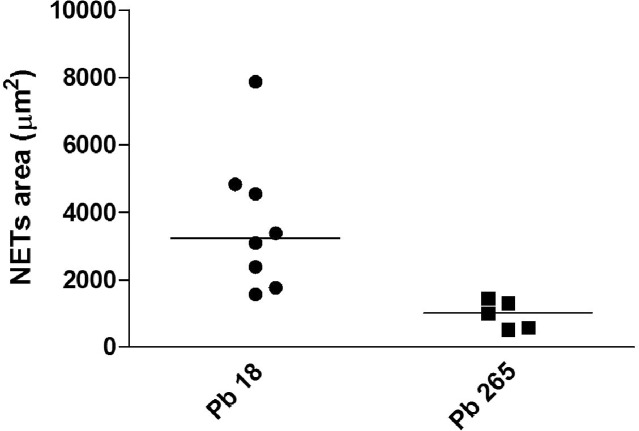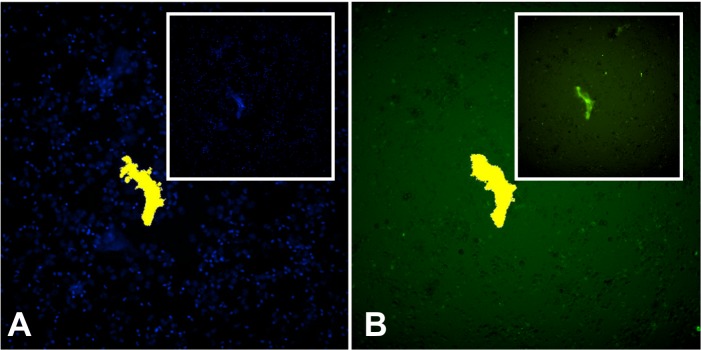Abstract
Paracoccidioidomycosis (PCM) is a systemic mycosis, endemic in most Latin American countries, especially in Brazil. It is caused by the thermo-dimorphic fungus of the genus Paracoccidioides (Paracoccidioides brasiliensis and Paracoccidioides lutzii). Innate immune response plays a crucial role in host defense against fungal infections, and neutrophils (PMNs) are able to combat microorganisms with three different mechanisms: phagocytosis, secretion of granular proteins, which have antimicrobial properties, and the most recent described mechanism called NETosis. This new process is characterized by the release of net-like structures called Neutrophil Extracellular Traps (NETs), which is composed of nuclear (decondensed DNA and histones) and granular material such as elastase. Several microorganisms have the ability of inducing NETs formation, including gram-positive and gram-negative bacteria, viruses and some fungi. We proposed to identify NETs in tegumentary lesions of patients with PCM and to analyze the interaction between two strains of P. brasiliensis and human PMNs by NETs formation in vitro. In this context, the presence of NETs in vivo was evidenced in tegumentary lesions of patients with PCM by confocal spectrum analyzer. Furthermore, we showed that the high virulent P. brasiliensis strain 18 (Pb18) and the lower virulent strain Pb265 are able to induce different patterns of NETs formation in vitro. The quantification of extracellular DNA corroborates the idea of the ability of P. brasiliensis in inducing NETs release. In conclusion, our data show for the first time the identification of NETs in lesions of patients with PCM and demonstrate distinct patterns of NETs in cultures challenged with fungi in vitro. The presence of NETs components both in vivo and in vitro open new possibilities for the detailed investigation of immunity in PCM.
Author Summary
Paracoccidioidomycosis (PCM) is an infectious disease caused by fungi of genus Paracoccidioides (P. brasiliensis and P. lutzii). PCM is endemic in Latin America, with a greater incidence in Brazil, Colombia, and Argentina. Over the last years, studies are focusing on neutrophils’ (PMNs) actions against P. brasiliensis, due to the capacity of these cells to develop different defense strategies against pathogens. and especially due to constant presence of inflammatory infiltrates full of PMNs in the granuloma of the disease. As PMN release of both granular and nuclear material, identified as Neutrophil Extracellular Traps (NETs), is a spectacular action mechanism against microbes, we seek to identify whether this process would be an important mechanism triggered against P. brasiliensis. Thus, we showed for the first time the identification of NETs in tegumentary lesions of patients with PCM by viewing the individual components of NETs. Beyond that, we demonstrated the entrapment of P. brasiliensis in vitro by these structures released from human PMNs of patients with PCM and healthy donors, with different patterns, in a dependence of the evaluated strain. Our data provides important new information regarding the role of PMNs against P. brasiliensis, opening new avenues for the research on immunity of PCM.
Introduction
Paracoccidioidomycosis (PCM) is a systemic mycosis considered an important cause of mortality and morbidity in most Latin American countries, especially in Brazil. Sporadic cases have been reported in European countries, United States of America (USA) and Japan, in individuals coming from endemic areas [1–5]. It is caused by the fungi of the genus Paracoccidioides (Paracoccidioides brasiliensis and Paracoccidioides lutzii) [6,7], which share the same thermo-dimorphic features, developing as mycelium at room temperature and as yeast at body temperature [8,9]. P. brasiliensis infection occurs after propagules inhalation (conidia presented in water, soil and plants) [10,11], which are deposited in the lungs and transformed into yeast cells, establishing the disease. From this stage on, infection could become latent (PCM–infection), disseminate by lympho-haematogenic pathway to other organs, such as liver and spleen (PCM–disease), or heal spontaneously [11].
Innate immune response is essential during early stages of fungal infections [12]. Phagocytic cells, such as neutrophils (PMNs) and macrophages, play crucial role in host defense, modulating the inflammatory response and fungicidal activity against P. brasiliensis [12–17]. In this context, studies have focused on the role of PMNs during PCM, since a massive infiltration of these cells is found in granulomas of the disease, after chemoattraction modulated by keratinocyte chemoattractant (KC) and macrophage inflammatory protein 1 alpha (MIP-1α) [18].
PMNs are short-lived cells that must be promptly recruited to the site of infection [19]. They can capture and kill microbes by oxygen dependent or independent mechanisms, by the action of NADPH enzyme or release of their granular components [19]. Reactive oxygen species (ROS), produced by the action of NADPH enzyme are essential for the killing of fungi [14,15,20–23]. Previous studies demonstrated that non-activated PMNs do not have fungicidal activity, just showing fungistatic activity against P. brasiliensis [24], with an increase in these functions after activation with cytokines such as interferon-gamma (IFN-γ), tumor necrosis factor-alpha (TNF-α), granulocyte monocyte colony-stimulating factor (GM-CSF) and interleukin-15 (IL -15) [24–27]. The studies also showed that the effector mechanisms of activated PMNs against fungi involve superoxide anions and H2O2 participation.
A novel PMN mechanism of action has been described as NETosis, which is an extracellular mechanism to kill microbes characterized by the PMN release of both granular and nuclear material and identified as Neutrophil Extracellular Traps (NETs) [28]. These structures are composed by a decondensed DNA backbone associated with histones and others antimicrobial proteins such as elastase, permeability increasing protein (BPI) and myeloperoxidase [28,29]. NETs can be triggered by gram-positive and gram-negative bacteria, fungi, protozoa and viruses, some molecules like interleukin-8 (IL-8), Phorbol Myristate Acetate (PMA), lipopolysaccharide (LPS) and others cells as activated platelets [28,30–34], showing until now, that several microorganisms are able to induce NETs formation. In some of them, NETs have antimicrobial activities, in others meanwhile, these structures have only temporary entrapment action, avoiding their dissemination [28,31,33–37].
Therefore, the aims of this study were to identify the presence of NETs in vivo, analyzing tegumentary lesions of patients with PCM, and in vitro, challenging human PMNs with P. brasiliensis yeast cells.
Materials and Methods
Casuistics
A prospective study was conducted to analyze skin tegumentary lesions of seven male patients between 51 and 75 years old, attended at clinical dermatology of the Botucatu Medical School, São Paulo State University. All patients had the chronic form of PCM with lesions localized at head, nose, hand, knee, foot and back. The diagnosis was confirmed by histopathological analysis performed by the Pathology Service/FMB. Patients were selected before treatment, excluding the immunocompromised ones and those with secondary infections.
PMNs from peripheral blood of PCM patients with the chronic form of the disease and healthy volunteer donors between 20 and 30 years from FMB were also evaluated in this study.
Ethics statement
This investigation was conducted according to the principles expressed in the Declaration of Helsinki and was approved by the Research Ethics Committee of Botucatu Medical School, UNESP–São Paulo State University (CEP—261/11). Written informed consent was obtained from all participants.
Isolation, purification and culture of human peripheral blood PMNs
Peripheral blood from patients and healthy donors was collected by venous puncture and PMNs were separated by a density gradient centrifugation (Histopaque 1119 and 1083g/mL—Sigma–Aldrich, St. Louis, USA) at 460 g for 30 minutes followed by erythrocytes lysis with a hypotonic solution (NaCl 0,2%). Cellular viability was assessed by trypan blue dye exclusion test, and purified PMNs (≥95% of the cells) were then resuspended in complete medium (RPMI medium 1640 supplemented with 10% inactivated fetal calf serum, both from Sigma–Aldrich) and placed on ice until use. Cell culture was adjusted for 2x106 cells/mL before all procedures.
Fungi
Two different strains of P. brasiliensis were used throughout this study: P. brasiliensis strain 18 (Pb18, high virulence) and strain 265 (Pb265, low virulence). The strains were submitted to weekly sub-cultivation on 2% glucose, 1% peptone, 0.5% yeast extract and 2% agar medium (GPY medium) (all reagents from DIFCO, Franklin Lakes, NJ, USA), and used on the sixth day of culture. For preparation of P. brasiliensis suspension, yeast cells were removed from the cultivation medium, transferred to a sterile test tube containing glass beads and homogenized in a Vortex homogenizer (two cicles of ten seconds). Yeast viability was determined by phase contrast microscopy and bright yeast cells were counted as viable while dark ones were considered as non-viable. Fungal suspensions containing more than 95% viable cells were used in the experiments. The yeast suspension was adjusted for 4x104 cells/mL before use.
Histopathological analysis
Tissue sections from biopsies of tegumentary lesions from seven PCM patients were fixed with buffered formalin, dehydrated in 70% alcohol and embedded in parafin. Samples (7μm thick) were deparaffinized and stained with hematoxylin and eosin (H&E), in attempt to identify the extracellular DNA, representative of NETs [38]. Sections of the same biopsies were stained with Gomori-Grocott to visualize yeast cells. Gomori-Grocott stain consists in oxidizing the sample with chromic acid 5%, bleaching with sodium bisulphite 1%, treating with methenamine silver solution until impregnation, toning with gold chloride 0.1%, fixing with sodium thiosulphate 3% and counterstaining with light green. Slides were scanned with the Pannoramic Digital Slide Scanners—Pannoramic MIDI (3DHISTECH Kft, Budapest, Hungary) and analyzed using software Pannoramic Viewer 1.15.4 RTM (3DHISTECH Kft), from NTDP (Digital Technologies in Pathology Facility, Dept. of Pathology–FMB).
NETs analysis by confocal laser scanning microscopy
The same biopsies were analyzed by confocal laser scanning microscopy. Tissue sections (7μm thick) were deparaffinized in two baths of 100% xylene and three baths of ethanol decreasing concentrations (100%, 90% and 70%). Samples were washed for 5 minutes in dH2O and incubated with a blocking buffer PBS-BSA 4% (nonspecific binding block) for 30 minutes. Tissues were incubated with anti-elastase (Calbiochem—Merck Millipore—Merck KGaA, Darmstadt, Germany) and anti-histone H1 (Millipore—Merck Millipore—Merck KGaA, Darmstadt, Germany) antibodies, followed by anti-rabbit-FITC (Millipore) and anti-mouse-Texas red (Calbiochem) antibodies, respectively. Slides were mounted using mounting medium for fluorescence with DAPI (Vectashield-Vector Labs, Burlingame, CA, USA).
Confocal images were taken in a Leica TCS SP5 microscope from the CME (Electron Microscopy Center–Biosciences Institute—UNESP—Botucatu).
NETs analysis by scanning electron microscopy
Isolated PMNs (2x106 cells/mL) from PCM patients and healthy donors were adhered on coverslips treated with Poly-L-Lysine 0, 01% (Sigma-Aldrich) in 24-well flat-bottom plates (Nunc Life Tech., Inc., MD, USA). In some cultures, after adherence, cells were pretreated with DNAse (100U/mL–Fermentas Life Science–St. Leon-Rot, Germany) for 30 minutes and/or PMA (100ng/mL- Sigma–Aldrich) as a negative and positive control respectively. PMNs were then challenged with Pb18 and Pb265 (4x104 cells/mL), using 50:1 cells/fungi ratio, and incubated for one or two hours in 5% CO2 at 37°C. Cocultures were fixed with 2.5% glutaraldehyde in 0.1 M cacodylate buffer, pH 7.2, postfixed with 1% osmium tetroxide, and dehydrated with an ascending ethanol series. After dehydration and critical-point drying, samples were coated with gold and analyzed in a FEI QUANTA 200 scanning electron microscope from the CME (Electron Microscopy Center–Biosciences Institute—UNESP—Botucatu).
High-content image acquisition and analysis of NETs
PMNs isolated from healthy donors were treated as described previously. For automated imaging acquisition, isolated PMNs (2x106 cells/mL) were treated with PMA–positive control (100 ng/mL–Sigma Aldrich) for 30 minutes or challenged with Pb18 or Pb265 (4x104 cells/mL – 50:1 cells/fungi ratio) and incubated for two hours in 5% at 37°C. After this period, cells were stained with anti-elastase antibody (Calbiochem), followed by anti-rabbit-FITC antibody (Millipore), fixed with 4% formaldehyde solution and DNA was stained with DAPI (Vectashield–Vector Labs). Following this, cultures were transferred into 96-well black/clear bottom microplate (Corning) at 2 × 105 cells/well in 100 μl microplates and were centrifuged at 2000 rpm for 5 minutes at 24°C. Images were acquired using the automated microscope ImageXpress Micro XL Widefield High-Content Screening System (Molecular Devices, Sunnyvale, CA) with a cooled 16-bit monochromes CMOS PCO camera (2160 × 2160 imaging array, 6.5 × 6.5 μm pixels) using an 20× Super Plan Fluor ELWD, NA 0.45 Nikon objective. Exposure times were 200 msec for DAPI (nuclear stain) and 500 msec for FITC (anti-elastase-FITC antibody). A total of 16 sites for each replicate (n = 5) was acquired from wells containing non-treated PMNs, 100 ng/ml PMA-activated cells, and PMNs incubated with Pb18 or Pb265 (50:1 ratio). Cellular image analysis was performed using MetaXpress software version 5.3.0.5. Average of total DNA stained by DAPI was quantified using a customized method with MetaXpress Custom Module Editor. Total area (μm2) of the resulting NETs in response to Pb18 and Pb265 was analyzed by thresholding NETs stained with DAPI and anti-elastase-FITC antibody and measured by Integrated Morphometry Analysis.
Quantification of NETs release by Picogreen dsDNA kit
PMNs (2x106 cells/mL) from healthy donors were incubated with or without Pb18 and Pb265 for two hours. In some assays, cultures were activated with PMA–positive control (100ng/mL—Sigma–Aldrich) or challenged with Pb18 and Pb265. After incubation, supernatants were collected and treated with restriction enzymes (EcoR1 and HindIII, 15U/uL each; Invitrogen, Eugene, Oregon, USA), according to the manufacturer's instructions. After, extracellular DNA amounts (NETs) were quantified using the Picogreen dsDNA kit (Invitrogen) used by several authors [33,34,39–41]. The λ-DNA standard provided with the kit (100μg/mL) was diluted with Tris-EDTA (TE buffer) to the concentration of 1ng/mL for the high range curve and received the same treatment with restriction enzimes. Plates were incubated at room temperature in the dark for 5 minutes prior reading on a SpectraMax M2 (Molecular Devices) using an excitation wavelength of 480 nm and emission wavelength of 520 nm.
Statistical analysis
Measure of NETs area was analyzed by Wilcoxon’s test. Average of total DNA structures and quantification of extracellular DNA were compared by Friedman’s test followed by post-hoc Dunn’s test with the level of significance set at p<0.05. All results were analyzed using GraphPad Prism 5.01 Software (Graphpad Software Inc., CA, USA).
Results
NETs identification by histopathological analysis
In attempt to identify extracellular structures suggestive of NETs, histopathological analysis of skin tegumentary lesions of patients with PCM was performed. In Fig 1A and 1B, the image revealed basophilic material with characteristic extracellular filaments, indicating extracellular DNA (positive for hematoxylin), suggestive of the formation of NETs, which are surrounding the yeasts at the lesion. Details of NETs and yeast cell were demonstrated in the highlighted area in Fig 1B (40x). In Fig 1C and 1D, the same tissue section was stained with Gomori-Grocott, as a positive control of the presence of P. brasiliensis in the site of lesion, corroborating the idea of the fungal participation on this process.
Fig 1. Histopathology of cutaneous lesions of patients with PCM showing Hematoxilin filamentous suggestive of NETs (white arrows) (A-20x and B-35x, insert-40x).
The same sample was stained with Gomori-Grocott, confirming the presence of P. brasiliensis in the lesion (black arrows) (C-20x and D-35x). (Bar size: A and C—100μm, B and D—50μm).
Individual components of NETs visualization by confocal laser scanning microscopy
After identification of the extracellular material suggestive of NETs by histopathological analysis, we seek to identify the individual components of NETs in biopsies from tegumentary lesions of patients with PCM (Fig 2). As expected, NETs were also visualized in these samples, and their constituents were evaluated individually. Decondensed DNA, the backbone of these structures, was identified after DAPI staining (Fig 2A). Histones (Histone H1) and elastase, other major NETs components, were identified combined with DNA after immunostaining with specific primary and secondary antibodies (Fig 2B and 2C). Interestingly, Fig 2D is the overlay of these three images, confirming the co-existence of the three major components constituting the NETs.
Fig 2. Confocal microscopy of NETs identified in skin lesions of patients with PCM.
Tissue was stained with DAPI (A), labeled with anti-elastase antibody followed by FITC-conjugated secondary antibody (B) and anti-histone H1 secondary antibody followed by Texas Red (C). In the last frame, the overlapping images (D). (Bar size 15μm).
We also identified during the analysis of one section (Fig 3), two cells that appear to be in an early stage of NETs formation. In the box (highlighted), we identified a nucleus labeled with DAPI (Fig 3A), which had lost its normal format and had positive staining for elastase (Fig 3B), demonstrating the colocalization of elastase with nuclear DNA. Elastase is transported to the nucleus, acting on histones to initiate the chromatin decondensation, even before it is released into the cytoplasm [42]. At the center of the field, we can observe a cell that appears to be releasing their decondensed DNA content (labeled with DAPI) (Fig 3A), already bound to elastase (Fig 3B), and the histone H1 in nuclear region (Fig 3C), indicating the mobilization of these compounds in the formation of NETs. In Fig 3D, the overlap of 3 images was observed. These images are very interesting as they have been identified in lesions of patients showing an active response of human PMNs through NETs formation against P. brasiliensis in vivo for the first time, once the fungus was identified by Gomori-Grocott in the lesion.
Fig 3. Confocal microscopy of NETs identified in skin lesions of patients with PCM.
Tissue was stained with DAPI (A), labeled with anti-elastase antibody followed by FITC-conjugated secondary antibody (B) and anti-histone H1 secondary antibody followed by Texas Red (C). In the last frame, the overlapping images (D). The highlights show the process of NETs formation. (Bar size 10μm).
NETs identification by scanning electron microscopy
To visualize NETs formation in vitro by scanning electron microscopy, PMN cultures from patients and healthy donors were challenged with two strains of P. brasiliensis: Pb18 (high virulence strain) and Pb265 (low virulence strain).
Non-treated PMNs from healthy donors were not able to release NETs, but in the presence of PMA, these structures were formed and visible after 45 minutes of incubation. PMA was able to induce an intense release of NETs that completely covered the observed area (Fig 4A).
Fig 4. Scanning electron microscopy from PMNs challenged with P. brasiliensis (50:1 ratio) in different periods of incubation showing NETs release.
(A) PMNs activated with PMA (100ng/mL) for 30 minutes. (B) PMNs challenged with Pb18 for one hour. (C) PMNs challenged with Pb18 for two hours. (D) PMNs challenged with Pb18 and treated with DNAse (100U/mL) for 30 minutes. (PMN–neutrophil; Pb–P. brasiliensis; NETs–Neutrophil Extracellular Traps).
Analyzing fungi-PMNs interaction, Pb18 was able to trigger NETs formation by PMNs in one and two hours of incubation (Fig 4B and 4C). Cultures with DNAse-1 treatment have not shown any evidence of NETs structures, confirming the enzyme’s degrading action upon the extracellular DNA structures (Fig 4D). We also observed that patient´s PMNs when challenged with both strains of P. brasiliensis (Pb18 and Pb265) released NETs in an attempt to entrap the fungi, possibly demonstrating the process of NETosis that may occur during in vivo infection with P. brasiliensis (Fig 5). However, distinct pattern of NETs in response to the different strains were detected. Analysis of cultures challenged with Pb18 revealed the presence of NETs in a large coverage area, and the structures seemed to be loose and scattered (Fig 5A and 5B). Whereas, Fig 5C and 5D demonstrated a different pattern of NETs when cells were challenged with Pb265. In these cultures, these structures looked smaller, denser and compacted when compared with Pb18 (Fig 5C and 5D). We observed that in Pb18 slides, practically all area was covered by NETs, while in Pb265 slides, NETs were concentrated near to the fungus.
Fig 5. Scanning electron microscopy from patients’ PMNs challenged with Pb18 (50:1 ratio) (A and B) or Pb265 (50:1 ratio) (C and D).
PMN cultures were challenged for two hours before analysis. (PMN–neutrophil; Pb–P. brasiliensis; NETs–Neutrophil Extracellular Traps).
High-content image acquisition and quantification of NETs
To corroborate data obtained by Confocal Microscopy and Scanning Electron Microscopy, we analyzed PMN cultures with the automated microscope ImageXpress Micro XL Widefield High-Content Screening System (Molecular Devices, Sunnyvale, CA). Once more, images showed an extracellular material stained with DAPI (DNA) and FITC (elastase), which characterized the presence of NETs in the cultures activated with PMA or challenged with Pb18 or Pb265 (Fig 6B, 6C and 6D, respectively). In Fig 6A, we observed non-treated PMNs, showing few PMNs in NETosis process, ratifying the idea that an activation is essential for NETs release. Whereas, in Fig 6B, when PMA was added to the culture, PMNs were able to release NETs to the extracellular environment. In Fig 6C and 6D, we observed Pb18 and Pb265, respectively, demonstrating the formation of NETs covering the yeast cells, certifying that this defense mechanism is triggered in the infection with P. brasiliensis.
Fig 6. High-content image acquisition of PMN cultures from healthy donors stained with DAPI (DNA) and anti-elastase antibody (FITC-green).
Non-treated PMNs (A), activated with PMA (100ng/mL) for 30 minutes (B), challenged with Pb18 (C) and with Pb265 (D) for two hours (50:1 ratio).
In addition to the obtained images, the same PMN cultures were analyzed in attempt to quantify the number of extracellular DNA structures, which represents NETs released after the culture’s challenge with Pb18, Pb265 or PMA activation. Analysis consisted in thresholding the structures stained with DAPI (DNA). Total DNA structures were quantified using a customized method with MetaXpress Custom Module Editor and measured by Integrated Morphometry Analysis presented as an average of extracellular DNA structures for each well. Corroborating our images, total extracellular DNA structures were substantially higher in the cultures activated with PMA or challenged with Pb18 or Pb265 when compared to non-treated PMNs, showing a significantly increase of extracellular DNA structures staining in cultures challenged mainly with Pb18 (p = 0.0016) (Fig 7). We also observed in these experiments, interesting different NETs patterns from cultures challenged with Pb18 or Pb265. Analyzing NETs area (μm2), that consisted in thresholding the structures stained with DAPI (DNA) colocalized with FITC (elastase), NETs from Pb18 coculture appeared to be bigger and more scattered than those presented by PMNs challenged with Pb265, which seemed to be smaller (p = 0.0625) (Fig 8), even though both are capable of entrapping the yeast cells as shown in Figs 5 and 6. Fig 9 was included to demonstrate how the software selected and performed the analysis.
Fig 7. Average of total extracellular DNA structures released by PMN cultures activated with PMA (100 ng/mL) for 30 minutes or challenged with Pb18 or Pb265 (50:1 ratio) for two hours (p = 0.0016).
Fig 8. Measure of NETs area (μm2) released by PMN cultures challenged with Pb18 or Pb265 (50:1 ratio) for two hours (p = 0.0625).
Fig 9. Image of the customized method with MetaXpress Custom Module Editor and measured by Integrated Morphometry Analysis.
Images were acquired using the automated microscope ImageXpress Micro XL Widefield High-Content Screening System (Molecular Devices, Sunnyvale, CA) with a cooled 16-bit monochromes CMOS PCO camera (2160 × 2160 imaging array, 6.5 × 6.5 μm pixels) using an 20× Super Plan Fluor ELWD, NA 0.45 Nikon objective. Total area (μm2) of the resulting NETs in response to Pb18 and Pb265 was analyzed by thresholding the NETs stained with DAPI and anti-elastase-FITC antibody and measured by Integrated Morphometry Analysis. (A) DAPI and (B) FITC.
We also analyzed NETs through quantification of the extracellular DNA by Picogreen dsDNA kit (Invitrogen). PMNs from healthy donors were incubated for two hours with both strains of P. brasiliensis (Pb18 and Pb265). Corroborating the data shown in scanning electron microscopy and High-Content Screening System, both Pb18 and Pb265 were also able to induce release of NETs in the extracellular environment. However, there was no statistical difference between the two strains of P. brasiliensis. Non-treated PMNs released low levels of DNA when compared with cultures treated with PMA, Pb18 and Pb265 (p = 0.0167) (Fig 10).
Fig 10. NETs quantification in vitro.
PMNs from healthy donors were stimulated with PMA (100 ng/mL) for 30 minutes or challenged with Pb18 and Pb265 (50:1 ratio) for two hours. Supernatants were collected, and DNA were quantified by Picogreen dsDNA kit (p = 0.0167).
Discussion
NETs action has been widely studied over the recent years. Several microorganisms are able to induce formation and release of these structures and in some cases, as in infections caused by Staphylococcus aureus, Shigella flexneri, Streptococcus pneumoniae, Leishmania amazonensis, Aspergillus fumigatus, Candida albicans, Aspergillus nidulans and P. brasiliensis, these NETs have antimicrobial activities [28,31,34,37,38,43–47]. Recent study demonstrated that PMNs selectively responds to pathogens that are too large to be phagocytosed via NETosis process [48]. However, some pathogens have evasion mechanisms that make the entrapment only temporary, enabling the recruitment of other immune cells for the site or inhibiting the microorganisms’ growth, as seeing in other infections [33,35–37,45,49].
The interaction between NETs and P. brasiliensis is still been investigated. In this study, we demonstrated for the first time NETs formation in vivo induced by P. brasiliensis yeast cells in tegumentary lesions of patients. Our results in vitro showed that yeasts are trapped by NETs, corroborating our previous study, in which were evidenced that P. brasiliensis yeast cells are able to induce NETs formation by PMNs and that these structures are involved in extracellular killing of the fungus [43]. However, our results also demonstrated different patterns of NETs in a dependence of the evaluated strain.
This study identified NETs components, such as histone and elastase, in both analyzes, in patient's tegumentary lesions and in PMN cultures, by confocal laser scanning microscopy and High-Content Screening System. Furthermore, it was identified in some tissue sections, cells in the initial process of NETs formation, demonstrating the colocalization of nuclear DNA with elastase, which is transported to the nucleus and acts on histones to initiate the chromatin decondensation, even before it is released into the cytoplasm. Papayannopoulos et al. [42] showed that elastase is necessary for chromatin decondensation through degradation of histones, allowing NETs release to the extracellular environment. Thus, we believe that the weak labeling of histone on this image was due the elastase action upon this component (Fig 3). Interestingly, the decondensed nuclear material labeled with DAPI that appears to be released by cells in some images, still have certain conserved nuclear structure. This is consistent with what has been recently proposed by some authors, that NETs can be formed by viable PMNs and that cell death can occur subsequently, once cell death is not a requirement for the formation of such structures [50–52].
Histopathological analysis was performed using H&E and Gomori-Grocott stainings and was included in this study in an attempt to identify structures that could indicate the presence of yeast cells in the local of NETs formation, characterized by basophilic material with extracellular filaments, indicating extracellular DNA positive for hematoxylin. Urban et al. [38] also identified the presence of NETs in histopathological analysis of mice challenged with C. albicans, evidencing the presence of extracellular DNA positive for hematoxylin, as seen in this study, corroborating once more our findings on the lesion analysis by confocal laser scanning microscopy. In this manner, the presence of NETs in tegumentary lesions strengthens the results obtained in the in vitro experiments, proving that there is a release of these NETs against the fungus after PMNs recruitment in vivo, once P. brasiliensis was identified in the lesion.
Scanning electron microscopy images showed similar structures as those first identified by Brinkmann et al. [28] and others [31,33,46]. In our images, the interaction between PMNs and P. brasiliensis yeast cells was evidenced, with consequent release of net like material, suggesting a role of NETs during PCM. These structures were similar to those seen in other microbe-NETs interaction like Mycobacterium tuberculosis, L. amazonensis and P. brasiliensis [33,34,43] and to images presented in previous studies with other fungi such as C. albicans, A. fumigatus, A. nidulans and Cryptococcus gattii [31,37,38,46,47,53].
However, when cells were challenged with different strains of P. brasiliensis, we identified a distinct pattern of NETs in a dependence of the evaluated strain. PMN cultures challenged with Pb18 showed presence of NETs in a large coverage area and these structures seemed to be loose and scattered, whereas NETs observed in PMN cultures challenged with Pb265 appeared to be smaller, denser and compacted, as shown in Scanning Electron Microscopy and by High Content analysis. We believe that this different NETs pattern might be related to an enzyme with DNAse like activity produced by Pb18 strain as a possible escaping mechanism avoiding a tight entrapment by NETs, which could contribute to the observed pattern. As demonstrated, in Pb18 genome (ABKI00000000.2) [54], there are two hypothetical proteins (PADG_11161—Gene ID: 22587058 and PADG_08285—Gene ID: 22586608) that have DNAse activities. Besides, it was already identified a deoxyribonuclease gene (PAAG_07587—Gene ID: 9093585) in P. lutzzi genome (ABKH00000000.2) [54]. Studies to better explain these hypothesis are been conducted in our lab. Beyond that, Buchanan (2006) have shown the production of DNAse by group A Streptococcus as an escaping mechanism from NETosis [55].
Although NETs have two important effector functions against microorganisms, as temporary imprison of the pathogen that prevents its spread and a direct antimicrobial action on trapped microorganisms, studies have also related NETs with several diseases, correlating them with pathological effects. Some reports show that antimicrobial histones and peptides coating the NET-DNA have direct cytotoxic effect to tissue, and ineffective clearance of NETs is responsible for deleterious inflammation of host tissue in several disorders [41,56–64]. In acute respiratory distress syndrome (ARDS), there is a massive influx of PMNs into the lungs causing neutrophilic inflammation and in acute lung injury (ALI), there is an excessive activation and migration of PMNs into the lung. These cells are important contributors to the progression of ALI/ARDS, and higher PMN concentration in the bronchoalveolar lavage (BAL) fluid of patients with ARDS is often associated with greater severity of the disease [64,65], while excessive PMNs and NETs contribute to the pathology of ALI, where NETs can directly induce lung epithelial cell death [62], relating NETs to the pathogenesis of these important lung diseases [57,59,60], as described above.
Therefore, this mechanism could also be involved with the pathogenesis of PCM, once it was described the presence of PMNs in inflammatory infiltrates of granulomas and in lesions detected in disease experimental models [66–70] and now the evidence of NETs in the lesions. Thus, the real participation of NETs in defense against P. brasiliensis or in disease’s pathogenesis, as well as the fungal escape mechanisms involved needs to be further investigated.
In conclusion, our data show for the first time the identification of NETs in patients’ tegumentary lesions. Beyond that, both strains of P. brasiliensis (Pb18 and Pb265) are able to induce NETs formation by human PMNs in vitro and are related to different patterns of NETs. The presence of NETs components both in vivo and in vitro open new possibilities for the detailed investigation of the immunity in PCM.
Acknowledgments
We would like to acknowledge Molecular Devices for providing the equipment for analysis (automated microscope ImageXpress Micro XL Widefield High-Content Screening System (Molecular Devices, Sunnyvale, CA), and Luciane Ganiko, Field Applications Scientist from Molecular Devices, by assisting us in acquiring and analyzing images. We also thank the CME (Electron Microscopy Center–Biosciences Institute—UNESP–Botucatu) for acquiring the images by Scanning Electron Microscopy and Confocal Laser Scanning Microscopy and the NTDP (Digital Technologies in Pathology Facility, Dept. of Pathology–FMB) for scanning the histopathological slides.
Data Availability
All relevant data are within the paper and its Supporting Information files.
Funding Statement
This work was suported by São Paulo Research Foundation (FAPESP 2011/18855-7), CNPq 480486/2011-5 and Fundunesp 00637/11-DFP; FAPESP MS fellowship (AMDC—FAPESP 2013/00788-7). The funders had no role in study design, data collection and analysis, decision to publish, or preparation of the manuscript.
References
- 1. Ginarte M, Pereiro M Jr, Toribio J. Imported paracoccidioidomycosis in Spain. Mycoses. 2003; 46(9–10):407–411. [DOI] [PubMed] [Google Scholar]
- 2. Van Damme PA, Bierenbroodspot F, Telgtt DS, Kwakman JM, De Wilde PC, Meis JF. A case of imported paracoccidioidomycosis: an awkward infection in The Netherlands. Med Mycol. 2006. February; 44(1):13–18. [DOI] [PubMed] [Google Scholar]
- 3. Bousquet A, Dussart C, Drouillard I, Charbel EC, Boiron P. Imported mycosis: a review of paracoccidioidomycosis. Med Mal Infect. 2007. December; 37 Suppl 3:S210–214. [DOI] [PubMed] [Google Scholar]
- 4. Mayayo E, López-Aracil V, Fernández-Torres B, Mayayo R, Domínguez M. Report of an imported cutaneous disseminated case of paracoccidioidomycosis. Rev Iberoam Micol. 2007. March; 24(1):44–46. [DOI] [PubMed] [Google Scholar]
- 5. Alsharif M, Martin AU, Shelton JB Jr, Pambuccian SE. Paracoccidioides brasiliensis in a liquid-based Papanicolaou test from a pregnant woman: report of a case. Diagn Cytopathol. 2008. August; 36(8):557–560. 10.1002/dc.20847 [DOI] [PubMed] [Google Scholar]
- 6. Matute DR, McEwen JG, Puccia R, Montes BA, San-Blas G, Bagagli E, et al. Cryptic speciation and recombination in the fungus Paracoccidioides brasiliensis as revealed by gene genealogies. Mol Biol Evol. 2006. January; 23(1):65–73. [DOI] [PubMed] [Google Scholar]
- 7. Teixeira MM, Theodoro RC, Carvalho MJ, Fernandes L, Paes HC, Hahn RC, et al. Phylogenetic analysis reveals a high level of speciation in the Paracoccidioides genus. Mol Phylogenet Evol. 2009. August; 52(2):273–283. 10.1016/j.ympev.2009.04.005 [DOI] [PubMed] [Google Scholar]
- 8. Restrepo A and Tobón AM. Paracoccidioides brasiliensis In: Principles and Practice of Infectious Diseases. Elsevier; 2005; 3062–3068. [Google Scholar]
- 9. Marques SA. Paracoccidioidomycosis: epidemiological, clinical, diagnostic and treatment up-dating. An Bras Dermatol. 2013. Sep-Oct; 88(5):700–711. 10.1590/abd1806-4841.20132463 [DOI] [PMC free article] [PubMed] [Google Scholar]
- 10. da Silva Neto BR, Carvalho PFZ, Bailão AM, Martins WS, Soares CMA, Pereira M. Transcriptional profile of Paracoccidioides spp. In response to itraconazole. BMC Genomics. 2014. April 1; 15:254 10.1186/1471-2164-15-254 [DOI] [PMC free article] [PubMed] [Google Scholar]
- 11. Franco M, Peraçoli MTS, Soares AMVC, Montenegro R, Mendes RP, Meira DA. Host-parasite relationship in paracoccidioidomycosis. Curr Top Med Mycol. 1993; 5:115–149. [PubMed] [Google Scholar]
- 12. Nicola AM, Casadevall A, Goldman DL. Fungal killing by mammalian phagocytic cells. Curr Opin Microbiol. 2008. August; 11(4):313–317. 10.1016/j.mib.2008.05.011 [DOI] [PMC free article] [PubMed] [Google Scholar]
- 13. do Nascimento MP, de Campos Soares AM, Dias-Melicio LA, Parise-Fortes MR, Martins RA, Nakaira ET, et al. Fungicidal activity of human monocyte-derived multinucleated giant cells induced in vitro by Paracoccidioides brasiliensis antigen. Mycopathologia. 2008. July; 166(1):25–33. 10.1007/s11046-007-9051-6 [DOI] [PubMed] [Google Scholar]
- 14. Moreira AP, Dias-Melicio LA, Soares AMVC . Interleukin-10 but not Transforming Growth Factor beta inhibits murine activated macrophages Paracoccidioides brasiliensis killing: effect on H2O2 and NO production. Cell Immunol. 2010; 263(2):196–203. 10.1016/j.cellimm.2010.03.016 [DOI] [PubMed] [Google Scholar]
- 15. Bordon-Graciani Ap, Dias-Melicio LA, Acorci-Valerio MJ, Araujo JP Jr, de Campos Soares AM. Inhibitory effect of PGE 2 on the killing of Paracoccidioides brasiliensis by human monocytes can be reversed by cellular activation with cytokines. Med Mycol. 2012. October; 50(7):726–734. 10.3109/13693786.2012.676740 [DOI] [PubMed] [Google Scholar]
- 16. Rodrigues DR, Fernandes RK, Balderramas HA, Penitenti M, Bachiega TF, Calvi SA, et al. Interferon-gamma production by human neutrophils upon stimulation by IL-12, IL-15 and IL-18 and challenge with Paracoccidioides brasiliensis . Cytokine. 2014. September; 69(1):102–109. 10.1016/j.cyto.2014.05.009 [DOI] [PubMed] [Google Scholar]
- 17. Balderramas HA, Penitenti M, Rodrigues DR, Bachiega TF, Fernandes RK, Ikoma MR, et al. Human neutrophils produce IL-12, IL-10, PGE2 and LTB4 in response to Paracoccidioides brasiliensis. Involvment of TLR2, mannose receptor and dectin-1. Cytokine. 2014. May; 67(1):36–43. 10.1016/j.cyto.2014.02.004 [DOI] [PubMed] [Google Scholar]
- 18. Souto JT, Aliberti JC, Campanelli AP, Livonesi MC, Maffei CM, Ferreira BR, et al. Chemokine production and leukocyte recruitment to the lungs of Paracoccidioides brasiliensis infect mice is modulated by interferon-gamma. Am J Pathol. 2003. August; 163(2):583–590. [DOI] [PMC free article] [PubMed] [Google Scholar]
- 19. Segal AW. How Neutrophils Kill Microbes. Annu Rev Immunol. 2005; 23:197–223. [DOI] [PMC free article] [PubMed] [Google Scholar]
- 20. Moreira AP, Dias-Melicio LA, Peraçoli MT, Calvi SA, Victoriano de Campos Soares AM. Killing of Paracoccidioides brasiliensis yeast cells by IFN-gamma and TNF-alpha activated murine peritoneal macrophages: evidence of H(2)O(2) and NO effector mechanisms. Mycopathologia. 2008. July; 166(1):17–23. 10.1007/s11046-007-9046-3 [DOI] [PubMed] [Google Scholar]
- 21. Carmo JP, Dias-Melicio LA, Calvi SA, Peraçoli MT, Soares AM . TNF-alpha activates human monocytes for Paracoccidioides brasiliensis killing by an H2O2-dependent mechanism. Med Mycol. 2006. June; 44(4):363–368. [DOI] [PubMed] [Google Scholar]
- 22. Costa DL, Dias-Melicio LA, Acorci MJ, Bordon AP, Tavian EG, Peraçoli MT, et al. Effect of interleukin-10 on the Paracoccidioides brasiliensis by gamma-interferon activated human neutrophils. Microbiol Immunol. 2007; 51(1):73–80. [DOI] [PubMed] [Google Scholar]
- 23. Bannwart CF, Martins RA, Nakaira-Takahashi E, Dias-Melicio LA, Soares AM, Peraçoli MT. Interleukin-15 augments oxidative metabolism and fungicidal activity of human monocytes against Paracoccidioides brasiliensis . Mem Inst Oswaldo Cruz. 2010. November; 105(7):866–872. [DOI] [PubMed] [Google Scholar]
- 24. Kurita N, Oarada M, Ito E, Miyaji M. Antifungal activity of human polymorphonuclear leucocytes against yeast cells of Paracoccidioides brasiliensis . Med Mycol. 1999. August; 37(4):261–267. [PubMed] [Google Scholar]
- 25. Kurita N, Oarada M, Miyaji M, Ito E. Effect of cytokines on antifungal activity of human polymorphonuclear leucocytes against yeast cells of Paracoccidioides brasiliensis . Med Mycol. 2000. April; 38(2):177–182. [DOI] [PubMed] [Google Scholar]
- 26. Rodrigues DR, Dias-Melicio LA, Calvi AS, Peraçoli MT, Soares AM. Paracoccidioides brasiliensis killing by IFN-gamma, TNF-alpha and GM-CSF activated human neutrophils: role for oxygen metabolites. Med Mycol. 2007. February; 45(1):27–33. [DOI] [PubMed] [Google Scholar]
- 27. Tavian EG, Dias-Melicio LA, Acorci MJ, Graciani AP, Peraçoli MT, Soares AM. Interleukin-15 increases Paracoccidioides brasiliensis killing by human neutrophils. Cytokine. 2008. January; 41(1):48–53. [DOI] [PubMed] [Google Scholar]
- 28. Brinkmann V, Reichard U, Goosmann C, Fauler B, Uhlemann Y, Weiss DS, et al. Neutrophil extracellular traps kill bacteria. Science. 2004. March 5; 303(5663):1532–1535. [DOI] [PubMed] [Google Scholar]
- 29. von Köckritz-Blickwede M, Nizet V. Innate immunity turned inside-out: antimicrobial defense by phagocyte extracellular traps. J Mol Med (Berl). 2009. August; 87(8):775–783. [DOI] [PMC free article] [PubMed] [Google Scholar]
- 30. Martinelli S, Urosevic M, Daryadel A, Oberholzer PA, Baumann C, Fey MF, et al. Induction of genes mediating interferon-dependent extracellular trap formation during neutrophil differenciation. J Biol Chem. 2004. October 15; 279(42):44123–44132. [DOI] [PubMed] [Google Scholar]
- 31. Urban CF, Reichard U, Brinkmann V, Zychlinsky A. Neutrophil extracellular traps capture and kill Candida albicans yeast and hyphal forms. Cell Microbiol. 2006. April; 8(4):668–676. [DOI] [PubMed] [Google Scholar]
- 32. Grinberg N, Elazar S, Rosenshine I, Shpigel NY. Beta-hydroxybutyrate abrogates formation of bovine neutrophil extracellular traps and bactericidal activity against mammary pathogenic Escherichia coli . Infect Immun. 2008. June; 76(6):2802–2807. 10.1128/IAI.00051-08 [DOI] [PMC free article] [PubMed] [Google Scholar]
- 33. Ramos-Kichik V, Mondragon-Flores R, Mondragon-Castelan M, Gonzalez-Pozos S, Muñiz-Hernandez S, Rojas-Espinosa O, et al. Neutrophil extracellular traps are induced by Mycobacterium tuberculosis . Tuberculosis (Edinb). 2009. January; 89(1):29–37. [DOI] [PubMed] [Google Scholar]
- 34. Guimarães-Costa AB, Nascimento MTC, Froment GS, Soares RP, Morgado FN, Conceição-Silva S, et al. Leishmania amazonensis promastigotes induce and are killed by neutrophil extracellular traps. Proc Natl Acad Sci USA. 2009. April 21; 106(16):6748–6753. 10.1073/pnas.0900226106 [DOI] [PMC free article] [PubMed] [Google Scholar]
- 35. Menegazzi R, Decleva E, Dri P. Killing by neutrophil extracellular traps: fact or folklore? Blood. 2012. February 2; 119(5):1214–1216. 10.1182/blood-2011-07-364604 [DOI] [PubMed] [Google Scholar]
- 36. Malachowa N, Kobayashi SD, Freedman B, Doward DW, DeLeo FR. Staphylococcus aureus Leukotoxin GH promotes formation of Neutrophil Extracellular Traps. J Immunol. 2013. December 15; 191(12):6022–6029. 10.4049/jimmunol.1301821 [DOI] [PMC free article] [PubMed] [Google Scholar]
- 37. McCormick A, Heesemann L, Wagener J, Marcos V, Hartl D, Loeffler J, et al. NETs formed by human neutrophils inhibit growth of the pathogenic mold Aspergillus fumigatus . Microbes Infect. 2010. November; 12(12–13):928–936. 10.1016/j.micinf.2010.06.009 [DOI] [PubMed] [Google Scholar]
- 38. Urban CF, Ermert D, Schmid M, Abu-Abed U, Goosmann C, Nacken W, et al. Neutrophil extracellular traps contain calprotectin, a cytosolic protein complex involved in host defense against Candida albicans . PLoS Pathog. 2009. October; 5(10): e1000639 10.1371/journal.ppat.1000639 [DOI] [PMC free article] [PubMed] [Google Scholar]
- 39. Gabriel C, McMaster WR, Girard D, Descoteaux A. Leishmania donovani promastigotes evade the antimicrobial activity of neutrophil extracellular traps. J Immunol. 2010. October 1; 185(7):4319–4327. 10.4049/jimmunol.1000893 [DOI] [PubMed] [Google Scholar]
- 40. Byrd AS, O´Brien XM, Johnson CM, Lavigne LM, Reichner JS. An extracellular matrix based mechanism of rapid neutrophil extracellular trap formation in response to Candida albicans . J Immunol. 2013. April 15; 190(8):4136–4148. 10.4049/jimmunol.1202671 [DOI] [PMC free article] [PubMed] [Google Scholar]
- 41. Leffler J, Martin M, Gullstrand B, Tydén H, Lood C, Truedsson L, et al. Neutrophil extracellular traps that are not degraded in systemic lupus erythematosus activate complement exacerbating the disease. J Immunol. 2012. April 1; 188(7):3522–3531. 10.4049/jimmunol.1102404 [DOI] [PubMed] [Google Scholar]
- 42. Papayannopoulos V, Metzler KD, Hakkim A, Zychlinsky A. Neutrophil elastase and myeloperoxidase regulate the formation of neutrophil extracellular traps. J Cell Biol. 2010. November 1; 191(3):677–691. 10.1083/jcb.201006052 [DOI] [PMC free article] [PubMed] [Google Scholar]
- 43. Bachiega TF, Fernandes RK, Rodrigues DR, Balderramas HA, Dias-Melicio LA, Soares AMVC . Paracoccidioides brasiliensis induces neutrophil extracellular traps in vitro. Front Immunol 2013. [Google Scholar]
- 44. Mejía SP, Cano LE, López JA, Hernandez O, González Á. Human neutrophils produce extracellular traps against Paracoccidioides brasiliensis . Microbiology. 2015. May; 161(Pt 5):1008–1017. 10.1099/mic.0.000059 [DOI] [PubMed] [Google Scholar]
- 45. Wartha F, Beiter K Albiger B, Fernebro J, Zychlinsky A, Normark S, et al. Capsule and D-alanylated lipoteichoic acids protects Streptococcus pneumoniae against neutrophil extracellular traps. Cell Microbiol. 2007. May; 9(5):1162–1171. [DOI] [PubMed] [Google Scholar]
- 46. Bruns S, Kniemeyer O, Hasenberg M, Aimanianda V, Nietzsche S, Thywissen A, et al. Production of extracellular traps against Aspergillus fumigatus in vitro and in infected lung tissue is dependent on invading neutrophils and influenced by hydrophobin RodA. PLoS Pathog. 2010. April 29; 6(4):e1000873 10.1371/journal.ppat.1000873 [DOI] [PMC free article] [PubMed] [Google Scholar]
- 47. Bianchi M, Hakkim A, Brinkmann V, Siler U, Seger RA, Zychlinsky A, et al. Restoration of NET formation by gene therapy in CGD controls aspergillosis. Blood. 2009. September 24; 114(13):2619–2622. 10.1182/blood-2009-05-221606 [DOI] [PMC free article] [PubMed] [Google Scholar]
- 48. Branzk N, Lubojemska A, Hardison SE, Wang Q, Gutierrez MG, Brown GD, et al. Neutrophils sense microbe size and selectively release neutrophil extracellular traps in response to large pathogens. Nat Immunol. 2014. November; 15(11):1017–1025. 10.1038/ni.2987 [DOI] [PMC free article] [PubMed] [Google Scholar]
- 49. Guimarães-Costa AB, De Souza-Vieira TS, Paletta-Silva R, Freitas-Mesquita AL, Meyer-Fernandes JR, Saraiva EM . 3'-nucleotidase/nuclease activity allows Leishmania parasites to escape killing by neutrophil extracellular traps. Infect Immun. 2014. April; 82(4):1732–1740. 10.1128/IAI.01232-13 [DOI] [PMC free article] [PubMed] [Google Scholar]
- 50. Clark SR, Ma AC, Tavener SA, McDonald B, Goodarzi Z, Kelly MM, et al. Platelet TLR4 activates neutrophil extracellular traps to ensnare bacteria in septic blood. Nat Med. 2007. April; 13(4):463–469. [DOI] [PubMed] [Google Scholar]
- 51. Pilsczek FH, Salina D, Poon KK, Fahey C, Yipp BG, Sibley CD, et al. A novel mechanism of rapid nuclear neutrophil extracellular trap formation in response to Staphylococcus aureus . J Immunol. 2010. December 15; 185(12):7413–7425. 10.4049/jimmunol.1000675 [DOI] [PubMed] [Google Scholar]
- 52. Simon D, Simon HU, Yousefi S. Extracellular DNA traps in allergic, infectious, and autoimmune diseases. Allergy. 2013. April; 68(4):409–416. 10.1111/all.12111 [DOI] [PubMed] [Google Scholar]
- 53. Springer DJ, Chaturvedi V. Projecting global occurrence of Cryptococcus gattii . Emerg Infect Dis. 2010. January; 16(1):14–20. 10.3201/eid1601.090369 [DOI] [PMC free article] [PubMed] [Google Scholar]
- 54. Desjardins CA, Champion MD, Holder JW, Muszewska A, Goldberg J, Bailão AM, et al. Comparative genomic analysis of human fungal pathogens causing paracoccidioidomycosis. PLoS Genet. 2011. October; 7(10):e1002345 10.1371/journal.pgen.1002345 [DOI] [PMC free article] [PubMed] [Google Scholar]
- 55. Buchanan JT, Simpson AJ, Aziz RK, Liu GY, Kristian SA, Kotb M, et al. DNAse expression allows the pathogen group A Streptococcus to escape killing in neutrophil extracellular traps. Curr Biol. 2006. February 21; 16(4): 396–400. [DOI] [PubMed] [Google Scholar]
- 56. Xu J, Zhang X, Pelayo R, Monestier M, Ammollo CT, Semararo F, et al. Extracellular histones are major mediators of cell death in sepsis. Nat Med. 2009. November; 15(11):1318–1321. 10.1038/nm.2053 [DOI] [PMC free article] [PubMed] [Google Scholar]
- 57. Döring Y, Manthey HD, Drechsler M, Lievens D, Megens RT, Soehnlein O, et al. Auto-antigenic protein-DNA complexes stimulate plasmocytoid dendritic cells to promote atherosclerosis. Circulation. 2012. April 3; 125(13):1673–1683. 10.1161/CIRCULATIONAHA.111.046755 [DOI] [PubMed] [Google Scholar]
- 58. Kessenbrock K, Krumbholz M, Schönermarck U, Back W, Gross WL, Werb Z, et al. Netting neutrophils in autoimmune small-vessel vasculitis. Nat Med. 2009. June; 15(6):623–625. 10.1038/nm.1959 [DOI] [PMC free article] [PubMed] [Google Scholar]
- 59. Hakkim A, Fürnrohr BG, Amann K, Laube B, Abed UA, Brinkmann V, et al. Impairment of neutrophil extracellular trap degradation is associated with lupus nephritis. Proc Natl Acad Sci USA. 2010. May 25; 107(21):9813–9818. 10.1073/pnas.0909927107 [DOI] [PMC free article] [PubMed] [Google Scholar]
- 60. Lande R, Ganguly D, Facchinetti V, Frasca L, Conrad C, Gregorio J, et al. Neutrophils activate plasmocytoid dendritic cells by releasing self-DNA-peptide complexes in systemic lupus erythematosus. Sci Transl Med. 2011. March 9; 3(73):73ra19 10.1126/scitranslmed.3001180 [DOI] [PMC free article] [PubMed] [Google Scholar]
- 61. Liu CL, Tangsombatvisit S, Rosenberg JM, Mandelbaum G, Gillespie EC, Gozani OP, et al. Specific post-translational histone modifications of neutrophil extracellular traps as immunogens and potential targets of lupus autoantibodies. Arthritis Res Ther. 2012. February 2; 14(1):R25 10.1186/ar3707 [DOI] [PMC free article] [PubMed] [Google Scholar]
- 62. Saffarzadeh M, Juenemann C, Queisser MA, Lochnit G, Barreto G, Galuska SP, et al. Neutrophil extracellular traps directly induce epithelial and endothelial cell death: a predominant role of histones. PLoS One. 2012; 7(2):e32366 10.1371/journal.pone.0032366 [DOI] [PMC free article] [PubMed] [Google Scholar]
- 63. Rohrbach AS, Hemmers S, Arandjelovic S, Corr M, Mowen KA. PAD4 is not essential for disease in the K/BxN murine autoantibody-mediated model of arthritis. Arthritis Res Ther. 2012. May 2; 14(3):R104 10.1186/ar3829 [DOI] [PMC free article] [PubMed] [Google Scholar]
- 64. Cheng OZ, Palaniyar N . NET balancing: a problem in inflammatory lung diseases . Front Immunol. 2013. January 24; 4:1. [DOI] [PMC free article] [PubMed] [Google Scholar]
- 65. Grommes J, Soehnlein O. Contributions of neutrophils to acute lung injury. Mol Med. 2011. Mar-Apr; 17(3–4):293–307. 10.2119/molmed.2010.00138 [DOI] [PMC free article] [PubMed] [Google Scholar]
- 66. Uribe F, Zuluaga AI, León W, Restrepo A. Histopathology of cutaneous and mucosal lesions in human paracoccidioidomycosis. Rev Inst Med Trop Sao Paulo. 1987. Mar-Apr; 29(2):90–96. [DOI] [PubMed] [Google Scholar]
- 67. Araújo VC, Demasi AP, Soares AB, Passador-Santos F, Napimoga MH, Martinez EF, et al. Neutrophils in oral paracoccidioidomycosis and the involvement of Nrf2. PLoS One. 2013. October 24; 8(10): e76976 10.1371/journal.pone.0076976 [DOI] [PMC free article] [PubMed] [Google Scholar]
- 68. De Faveri J, Coelho KI, Rezkallah-Iwasso MT, Franco M . Hypersensitivity pneumonitis to Paracoccidioides brasiliensis antigens in mice. J Med Vet Mycol. 1989; 27(2): 93–104 [PubMed] [Google Scholar]
- 69. De Faveri J, Rezkallah-Iwasso MT, Franco MF. Pulmonary paracoccidioidomycosis in immunized mice. Mycopathologia. 1992. July; 119(1):1–9. [DOI] [PubMed] [Google Scholar]
- 70. Lopera D, Naranjo TW, Cruz OG, Restrepo A, Cano LE, Lenzi HL. Structural and topographic dynamics of pulmonary histopathology and local cytokine profiles in Paracoccidioides brasiliensis conidia-infected mice. PLoS Negl Trop Dis. 2011. July;5(7):e1232 10.1371/journal.pntd.0001232 [DOI] [PMC free article] [PubMed] [Google Scholar]
Associated Data
This section collects any data citations, data availability statements, or supplementary materials included in this article.
Data Availability Statement
All relevant data are within the paper and its Supporting Information files.



